I remember the first time I saw the photos from the series Unleash Your Herd’s Potential. I found them both eye-opening and distressing. Taken in an automated dairy farm, the images show how machines are handling animals on our behalf. It is not the pastoral images that the meat and dairy industry has used us to. Nor is it the kind of activist photos that lay bare the horrific conditions animals are submitted to in some industrial farms.
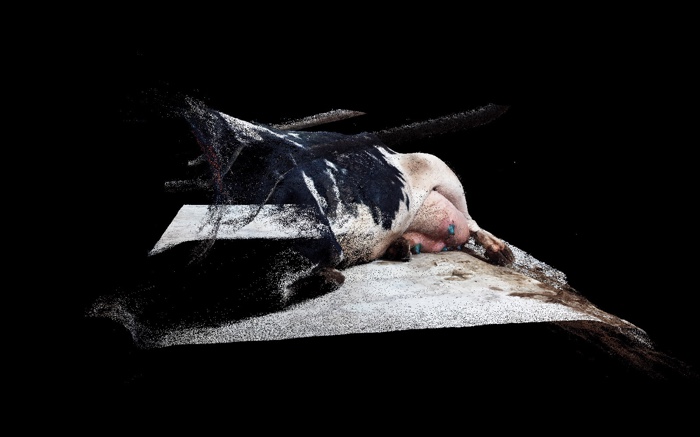
Daniel Szalai, Unleash Your Herd’s Potential, 2019–2022
Daniel Szalai, Unleash Your Herd’s Potential (Carousel-style milking parlour), 2019–2022
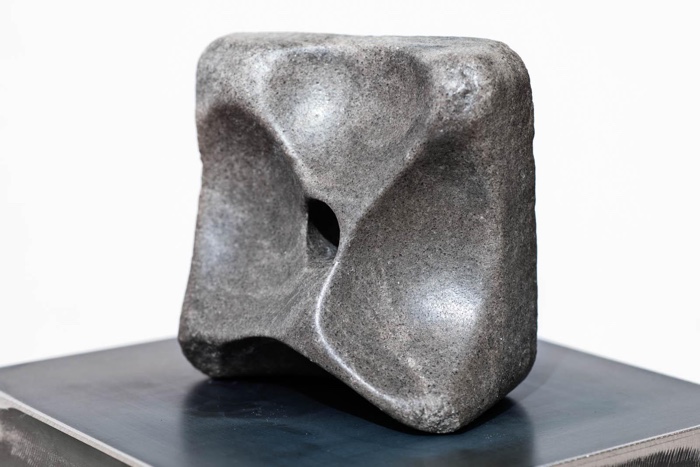
Daniel Szalai, Unleash Your Herd’s Potential, 2019–2022
The use of photogrammetry reveals the way the computer-controlled infrastructure quantifies every moment and aspect of a cow’s life. There are no humans about. Yet, each animal is adequately fed, the temperature is controlled, the stalls are clean. The cows, individually and collectively, have become mere datasets. With this series, Daniel Szalai shows how computer vision, AI and robotics are optimising the dairy industry, maximising the production while minimising any negative impact on the health of animals.
The work is accompanied by a collection of mineral salt licks given to the cows to enrich their diet. Manufactured as cubiform blocks, these cubes are shaped into anomalous, organic forms by the animals. “Thus,” the artist writes, “they can be regarded as symbols of the rebellion against our endeavour to turn living beings into parameterized commodities.”
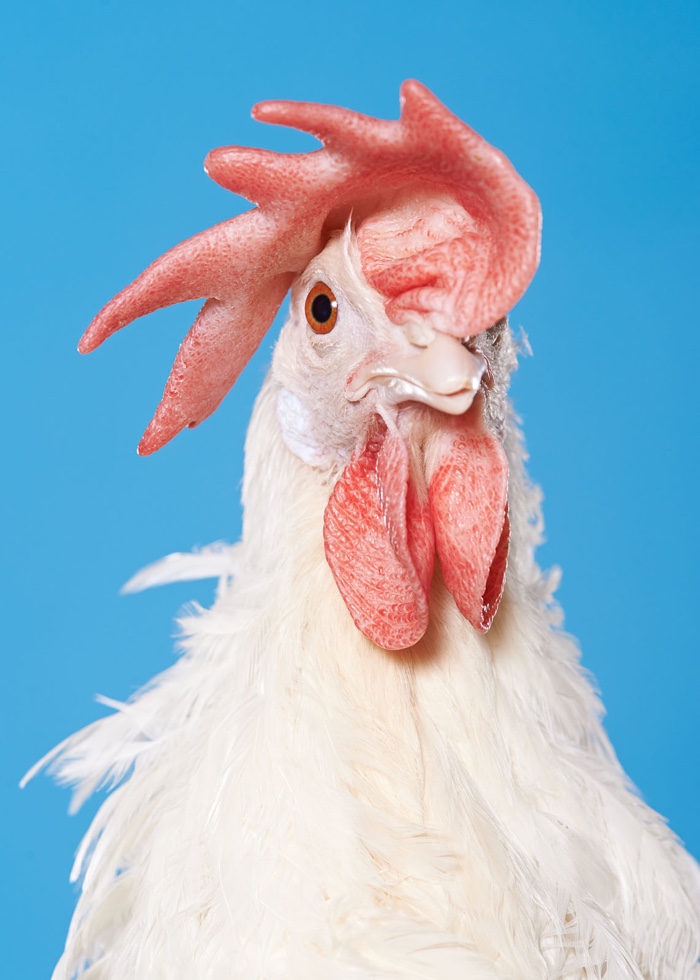
Daniel Szalai, Novogen, 2017–2018
Szalai’s Novogen series is possibly even more disturbing. The Novogen chickens live a life similar to the one endured by the cows. They never see the colour of the sky, never step on the grass and they grow in a perfectly sanitised environment. What they produce, though, will not end up on your kitchen table. Their eggs provide raw materials for the pharmaceutical industry.
Once laid, the eggs are pre-incubated in hatchers. The embryos are inoculated with a virus and then put back into the hatcher to further develop. The fluid found between the shell and embryo is later harvested and used as the basis of vaccines or medicines.
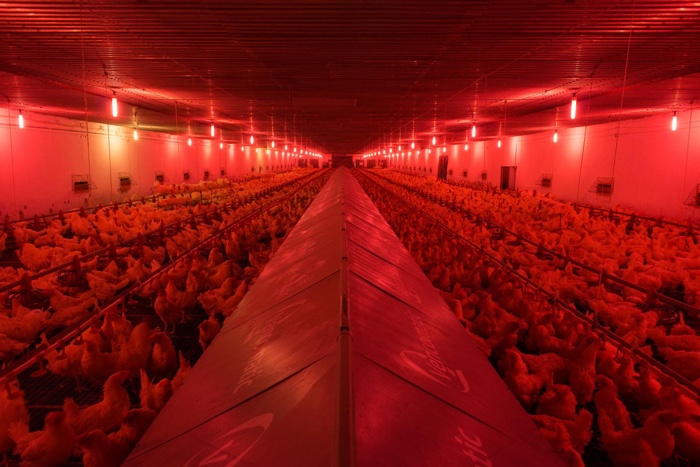
Daniel Szalai, Novogen, 2017–2018
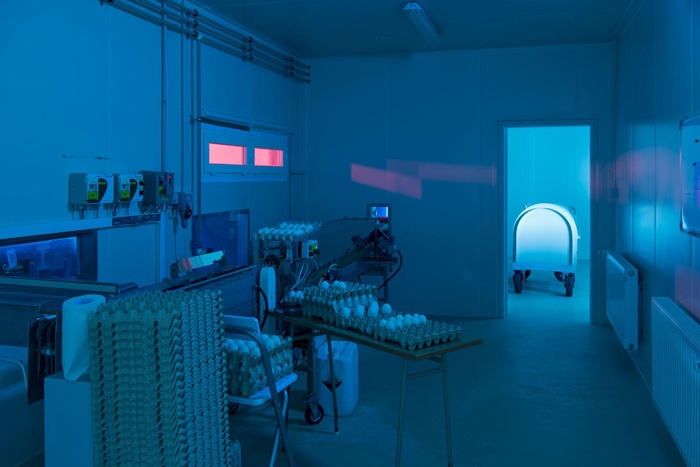
Daniel Szalai, Novogen, 2017–2018
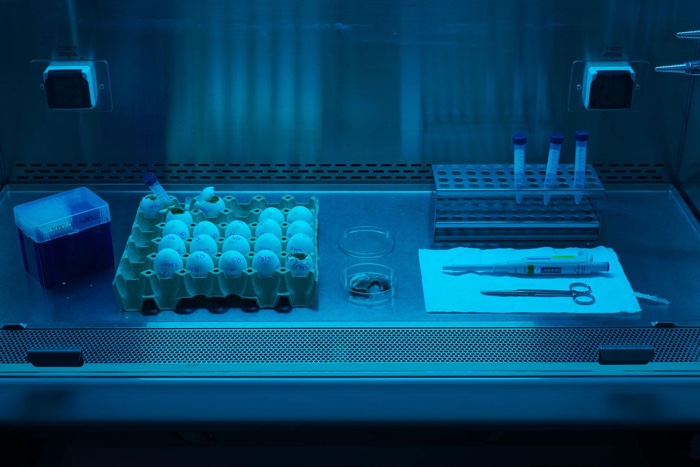
Daniel Szalai, Novogen, 2017–2018
Szalai’s photos show the various stages of vaccine fabrication. The colours of the production facility are particularly striking. The chickens are kept in a shed under computer-controlled red light. The red colour is supposed to accelerate sexual maturation in laying hens, subsequently boosting egg production and egg mass. In contrast, the laboratories and the hatching areas are bathed in either blue light or cold white light.
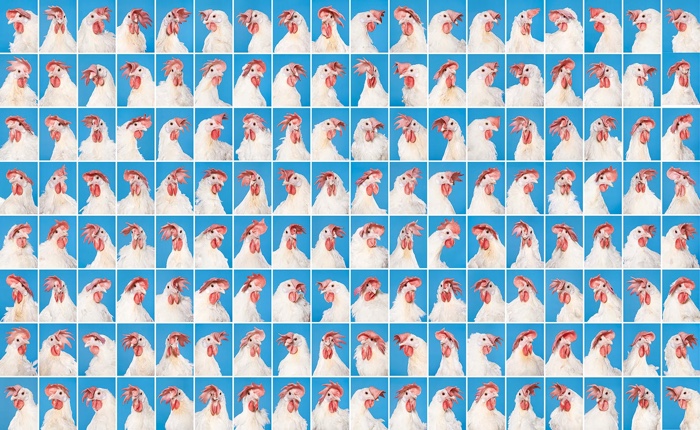
Daniel Szalai, Novogen, 2017–2018
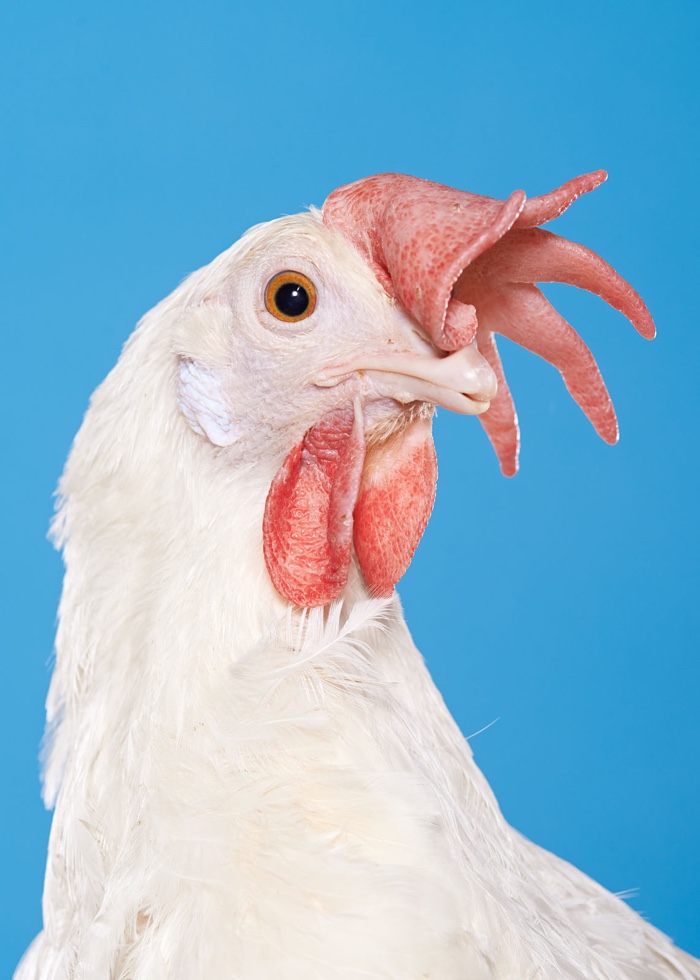
Daniel Szalai, Novogen, 2017–2018
The Novogen series also features 168 portraits of chickens. Each photo gives individuality to animals that were almost entirely engineered by men, live in completely artificial conditions and are advertised by the company as “products.”
Without adding drama and pathos, Szalai’s photos show how our general attitude towards non-human animals has evolved with the implementation of genetic interference, biochemistry and agricultural technology. Most of us are now almost entirely disconnected from the animals we use and consume. And yet we still feel a deep sense of unease in front of so much automation, quantification and utilitarian approach to nature.
Szalai uses animals to explore our relationship with nature and technology. The photos act as a mirror to our own contemporary life. Increasingly, our environment is mediated by technology. Increasingly, every parameter of our life is becoming quantifiable.
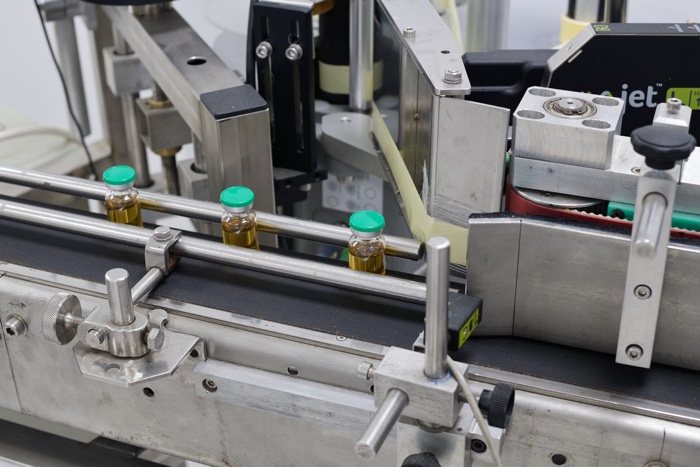
Daniel Szalai, Novogen, 2017–2018
Daniel Szalai is a Hungarian artist. His projects investigate peculiar manifestations of human-animal relationships and reflect on societal, political and economic anomalies. I got a chance to interview him over a video call a couple of weeks ago. Here’s a transcript of our conversation:
Hi Daniel!How did you get interested in the way we use animals for medical, economic and commercial purposes?
There is a very practical answer to this question. In 2017, I started doing a master’s degree at the Moholy-Nagy University of Art and Design in Budapest and, as a student, I also participated in the international talent program of BredaPhoto. In the framework of the program, we were asked to reflect on what technology does to humanity. I chose chicken as my subject focus because the chicken we know today is an almost entirely man-manipulated creature – a hybrid of natural and technological being.
The more personal answer to this question is that several influences lead me towards this research. I wanted to be a photographer since I was 12, but it took a while until I acknowledged this calling and embraced it. So at first, I studied Art and Design Theory for my BAs which developed my interest in social, political and philosophical questions. There were many debates about what technology does to humanity, what we call human, etc. All those conversations form part of the general background of my practice.
Another influence was a long-term relationship. While I studied Art and Design Theory, my girlfriend at that time studied veterinary medicine, a discipline that could be understood as loving an animal so much and understanding it so well that you can take it apart and then put it back together. The dichotomy and internal conflict of this instrumentalised and desacralised approach to an animal that, in fact, stems from a deep feeling of love and care interested me a lot.
Lastly, I used to work as a production and location manager in commercial film and photo production for over half a decade. This experience made me sceptical about the photographic medium and very disappointed in the capitalistic system that we live in.
All these influences and experiences got connected when I heard about Novogen layers, this special type of chicken that lays eggs for the pharmaceutical industry. After a friend of mine showed me a photo of a shed packed with thousands of these chickens, the puzzle suddenly made sense., I could emotionally connect and even identify with these chickens. It was the spark that helped me articulate so many of the things that had been on my mind for a while.
Eventually, the project Novogen unfolded into a larger series of works that define my last 6 years.
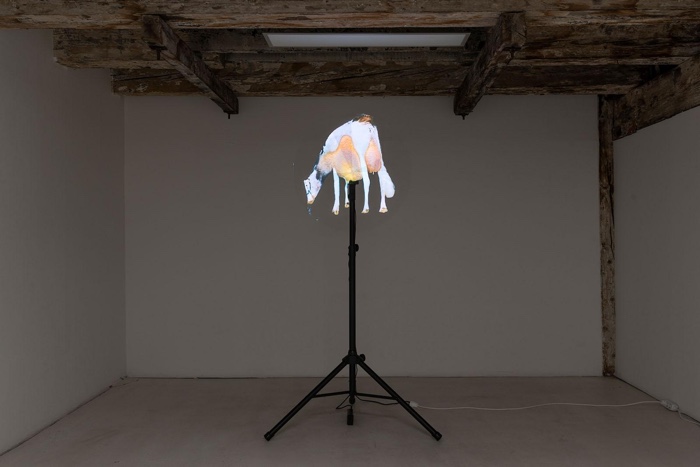
Daniel Szalai, Generation, 2021-2023
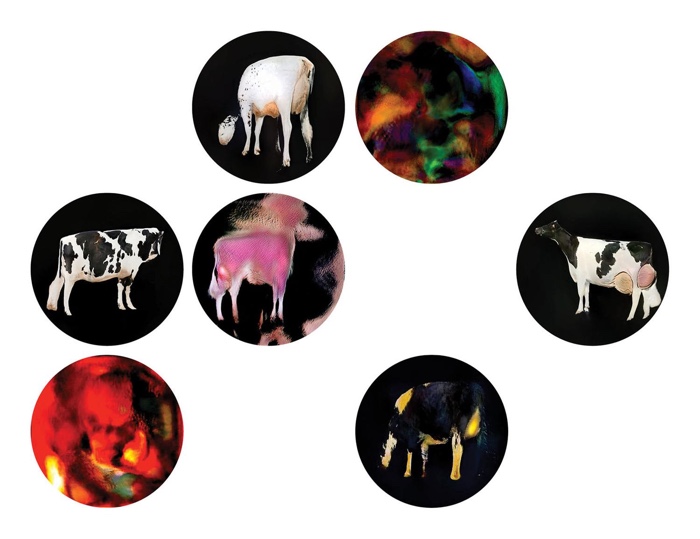
Daniel Szalai, Generation, 2021-2023
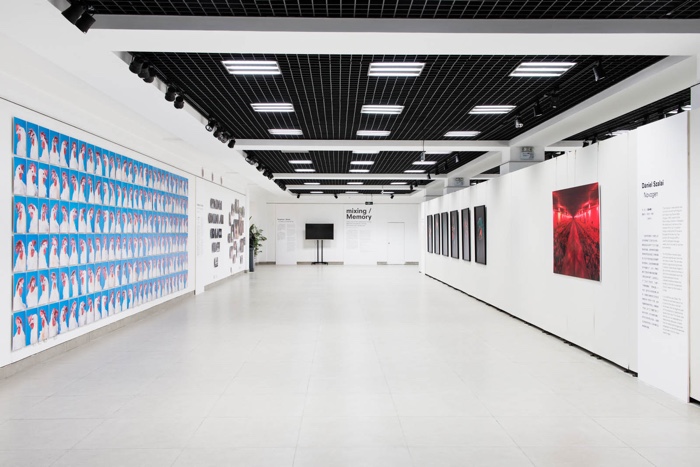
Exhibition view of Novogen at MIXING/ MEMORY by BREDAPHOTO, Yangzhou, China, 2019
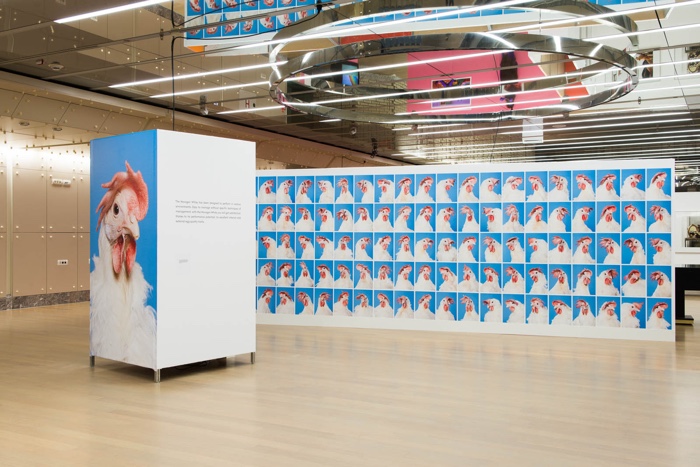
Exhibition view of Novogen at INSTINCT – Cankarjev dom, Ljubljana, Slovenia, 2019
What I admire about your work, and in particular in works like Unleash Your Herd’s Potential, Generation and Novogen, is that your approach seems to be factual and neutral. They are miles away from the kind of brutal and crude images that animal rights activists circulate. Yet, as a viewer, it is very difficult to remain neutral and indifferent in front of your images. They are very smooth and polished but we can still perceive an ambiguity. What kind of reaction do you get from the public when they see works like the ones that explore our techno-mediated relationship with non-human sentient beings?
Of course, I do have my opinion when I work on these projects but I always start by doing research as thoroughly as possible. It is important to be precise and knowledgeable about what I’m talking about. Besides, I’m critical of the phenomena that my work addresses but it is not my endeavour to engage in vulgar critique of what is going on. I like to present dilemmas and ask questions about my work.
Regarding neutrality, I believe that in many cases, reality is the greatest abstraction, the most metaphorical I could go. For example, the textual parts that I use in the Novogen project are actual texts from the management guide and the marketing materials of the company that produces these chickens. I believe that the way they speak about these animals is very expressive. Using these texts was a way to raise a number of questions and confront the viewer with interrogations about how we relate to these animals.
Similarly, the way I photographed the chickens may seem to be neutral at first glance. They are portrayed objectively, “as is”. However, the gesture of portraying them as individuals, as the factory workers of an industry, triggers a different connection to them. If you look in the eyes of these animals, you relate to them differently. Also, in stylistic terms of photography, I picture them on the threshold of portraiture and product photography which, I think, results in a provocative ambiguity.
With the project Unleash, again, my goal wasn’t to present suffering animals. In a way, I could even say that the project is not about the animals; it is not about the suffering individual, but the technology and the relationship we have with them.
I’m interested in the status quo. I’m interested in much larger systems and I want to offer the viewer an opportunity to look at these animals and ask questions.
Because of this ambiguity that you mentioned, the reactions of the viewers can vary. People usually understand where I am coming from but it is not such an easy thing. There is no single way of understanding the work. It’s about complex and intertwined questions related to technology, nature, human nature, capital, politics, culture, etc. It cannot be solved that easily. Most of the time this kind of identification with the animals does trigger empathy in people and because of that, a kind of adverse reaction to the situation.
The way we read these images, of course, also relies on our culture. For example, when Novogen was exhibited in China, I found that people had a perspective that was completely different from what I’m used to in the European context. The stake of the animal and the position of the animal is different in China so the local audience interpreted the work entirely differently. The reaction of the viewer depends on and also reveals a lot about their background and culture.
Interestingly, there was also an episode when I was attacked by an animal rights activist. They said that with the Novogen project, I participated in the torture of animals because I didn’t ask for their consent and I used them for my artistic work which caused the chicken to suffer.
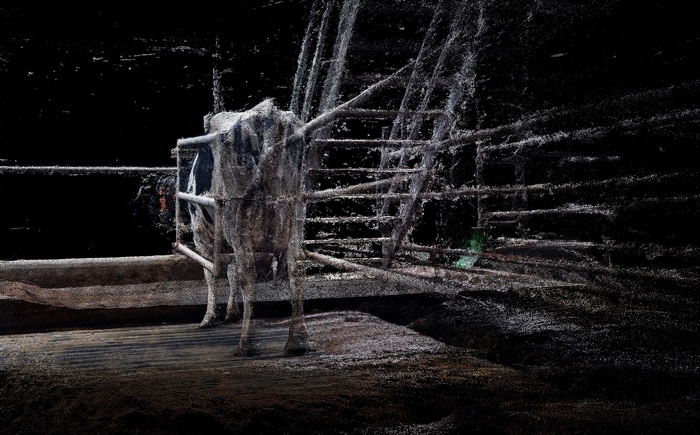
Daniel Szalai, Unleash Your Herd’s Potential, 2019–2022

Daniel Szalai, Unleash Your Herd’s Potential , 2019–2022
I’m also wondering how you got access to some of the places you photograph. Animal husbandry is usually depicted to us as a benign, traditional, almost natural endeavour. I don’t know how it is in Hungary but in several other European countries, it is very difficult to get access to warehouses that raise pigs, chickens and cows on an industrial scale. So how did you manage to get access to the locations presented in Unleash Your Herd’s Potential and in the Novogen series? As an artist, you are probably not perceived as a natural ally of the spaces that you visit for your projects…
Indeed, in most cases, artists are not welcome in these spaces because they pose a hazard and a threat, in particular because of their ambiguous and hard to define position.
Also, there is the health hazard that any individual entering these places poses. Because of that, even if your endeavours are perceived as positive, you might not get access since your visit poses a risk of infection.
However, as I mentioned earlier, I used to work as a production and location manager for five years. This means that convincing people to let us enter and shoot in locations that are not necessarily designed for that was part of my daily job. That experience helped me develop communication skills that are helpful for this kind of situation. But that’s not all: of course, I also need to find open-minded people to talk to.
With the Novogen project, I was lucky because the daughter of the farm’s owner used to work in the Museum of Fine Arts so she had a very good understanding of my intentions.
With Unleash, it helped a lot when trying to get access that I did my homework. Before reaching out to farmers, I read a lot about cattle breeding and dairy farming not only from the critical perspective of humanities and the arts but also in agricultural journals. I also attended conferences of precision agriculture and made interviews with different stakeholders like tech companies, as well as the Holstein Friesian Breeders Association in Hungary, a semi-governmental association that oversees the breeding strategy and breeding goals in every single farm around the country. I asked them to help me understand exactly how the system works, what is going on, etc. The staff of the Holstein Association appreciated my genuine interest in their work so much that eventually, they were nice enough to allow me to accompany them on their visits to different farms. They introduced me as colleagues so I showed up as kind of an informal member of the Association. Of course, sometimes I still had to prove my dedication during these visits and break the stereotype of the superficial urban photographer searching for sensational images. But in most cases, after we had a short conversation and they saw that I don’t mind being covered with manure, the farmers became friendly and supportive. Lastly, it also helped that I could present the work as part of my PhD research. That just sounded better.
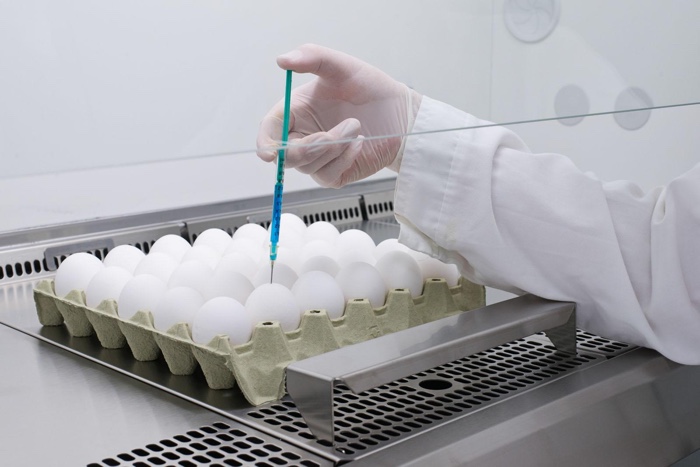
Daniel Szalai, Novogen, 2017–2018
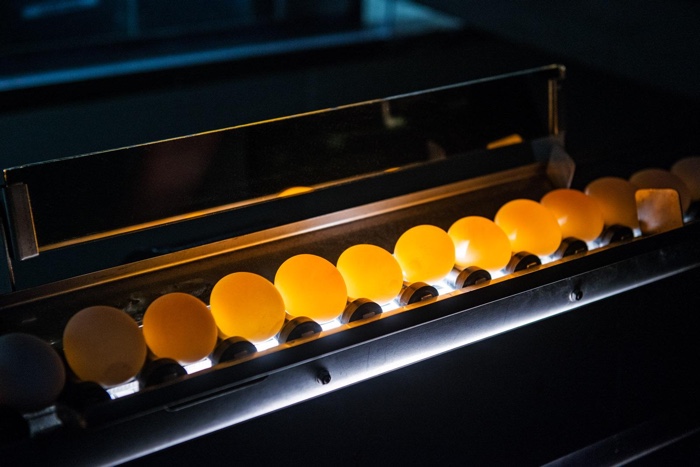
Daniel Szalai, Novogen, 2017–2018
I’m an animal rights activist and of course, I want all animals to live the most dignified life possible. However, I remember feeling very confused when I look at your Novogen series. I could only think about a time when my dad was very ill. I would have given anything to have him back in great shape. I realised that it is because we exploit these chickens that he could regain some health.
I think this dilemma is very important. It might be shocking or displeasing to see the industrialised life of Novogen chickens, but the fact that they are treated in such a way in order to produce life-saving vaccines and medicines paints their story with another perspective and calls us to consider the price paid to maintain our health and longevity.
When I started working on the project and first saw the deeply controlled life of these hens, which they spend entirely within isolated sheds, outside of which they would be unable to survive due to the lack of a proper immune system, I assumed that they are entirely dependent on us. However, the more I thought about it, the more obvious it got, especially during the pandemic that we are similarly dependent on them as they are on us, and our existence is just as fragile as these chickens’. We created a hygienically isolated realm for our species, and we were proven to be critically vulnerable to any intrusion of its boundaries. I think the story of Novogen hens reveals questions of a truly problematic, interconnected system of reliance. On the one hand, it tells about how much humanity is technological by nature and how much (bio)technology is now an inseparable part of us.
On the other hand, I find it interesting and telling that eggs haven’t been replaced with any other completely artificial material, and thus are still being used for manufacturing these pharmaceutical products. I think it reveals that however technologically advanced we become, we still remain dependent on nature. Even if, as in this case, nature does not directly refer to intact wilderness.
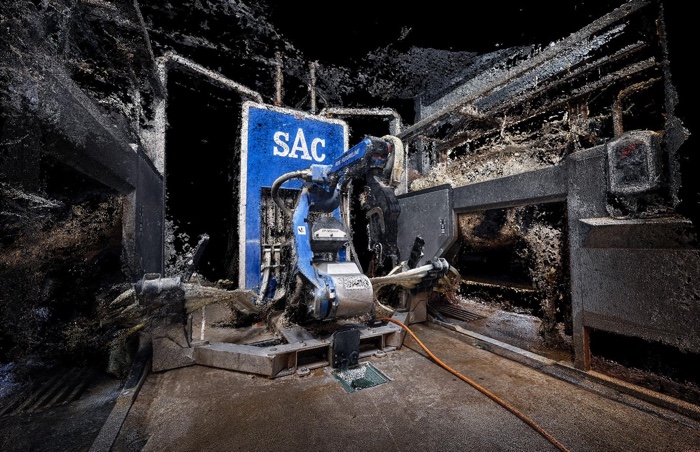
Daniel Szalai, Unleash Your Herd’s Potential, 2019–2022
Upon seeing Unleash Your Herd’s Potential, some people might be tempted to say that this level of optimisation and the continuous digital monitoring ensure the greatest wellbeing of the animals. Or that it doesn’t actually matter so much if animals are mere datasets if they are healthy and adequately fed. How would you respond to these remarks?
I’ve been to quite a few farms in Hungary, including fairly large industrial farms, and I have to say that according to my experience, these animals don’t suffer the way we usually see in footage often shown by animal activists. That kind of cruelty is not the norm. But this, of course, doesn’t mean that they live a decent, happy life. And this contradiction fascinates me. It is not the active suffering, but the system of exploitation that interests me.
This makes me think of domestication which is a key notion in my current research. In my view, domestication means becoming (seemingly) separated from the natural ecosystem and becoming part of an economic, political and technological ecosystem instead. In that sense, it is of paramount importance to grasp the status quo, and the systems we participate in together with such animals as chickens or cows.
In his book Sapiens, Yuval Noah Harari made two very interesting comments about domestication. The first one is that he describes it as a luxury trap. As he says, the Neolithic Revolution, the adoption of sedentism and the rise of agriculture offer a more secure life but also brought along a burden. As he points out, in fact, wheat domesticated us and not the other way around. It was the sapiens who moved to the house, to the domus, not the wheat.
The other thing that fascinates me is Harari’s comment on domestic animals. According to him, if you consider it only from the perspective of the number of replicas, certain animals may be regarded as the winners of the agricultural revolution. Pigs, chickens and cattle outnumber most wild animals. However, this number of replicas does not necessarily correlate with happiness. On the contrary, as Harari says, they are the most miserable beings ever lived on this planet. As I said, Novogen hens and most of the cows I’ve met were healthy and one could argue, well-kept. But this doesn’t mean that they lived a happy life in dignity.
Dairy cows living at automated dairy farms utilising computer vision, AI and robotics, live in nicely climatised sheds with an abundance of available food and water. They are free to move autonomously within the facilities. However, they spend their entire life in a closed system and actively participate in their exploitation in return for rewards.
This dichotomy, I feel, is also present in human society. if we consider starvation and physical well-being, we live in the most luxurious time in human history. But that doesn’t mean that humankind is happier or leading a more meaningful life on an individual level.
As you just noted, one could draw parallels between what these animals are subjected to and how human existence is being datafied and how our emotions are commodified. How does your work reflect our own relationship with technology?
Yes. In a sense, these companies use similar technologies as agricultural giants use to monitor and control their herds. Tech companies turn our personal, individual reality into data that can be commodified. As I said, in my view, we seem to share the burdens of today’s technological, economic and political reality with domesticated animals.
Any upcoming projects, fields of research or events you could share with us? Are you planning to keep on working on these issues of animals and domestication? Or do you feel like it’s time to move to something else?
No, nothing dramatically new yet. There is still enough emotional drive in me to investigate these questions. There are still many aspects that intrigue me and I’m currently working on some of them.
Thanks Daniel!
